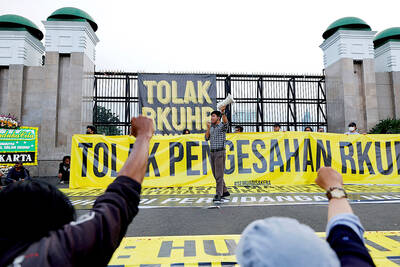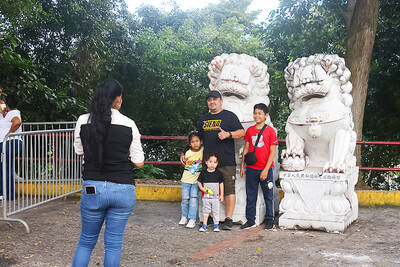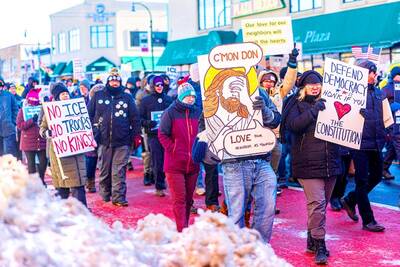The brawl between Han Chinese and Uighurs at a factory in southern China was scarcely covered by state media, but accounts and photos spread quickly via the Internet and became a spark that helped ignite deadly riots thousands of kilometers away in the Uighur homeland.
Even in tightly controlled China, relatively unfettered commentaries and images circulating on Web sites helped stir up tensions and rally people to join an initially peaceful protest in the Xinjiang region that spiraled into violence on Sunday, leaving more than 150 people dead.
In China, as in Iran and other hotspots, the Internet, social networking and micro-blogging are playing a central role in mobilizing people power — and becoming contested ground as governments fight back.
In the Internet age, events in “places like Xinjiang or Tibet, which were always considered very remote,” can suddenly become close and immediate for people around the world, said Xiao Qiang (蕭強), director of the Berkeley China Internet Project at the University of California-Berkeley.
Since the outburst in the Xinjiang capital of Urumqi, the Chinese government has blocked Twitter and Facebook, scrubbed news sites, unplugged the Internet entirely in some places and slowed it and cell phone service to a crawl in others to stifle reports about the violence — and get its own message out that authorities are in control.
Keyword filters have been activated on search engines like Baidu and Google’s Chinese version so that searches for “Xinjiang” or “Uighur” only turn up results that jibe with the official version of events.
That a fight in one part of China could generate a riot 10 days later thousands of kilometers away underscores how slippery fast-evolving communication technologies can be.
State media reports said only two people died in the June 25 fight between Uighur and Han Chinese workers at a toy factory in southern Shaoguan city. In the days that followed, however, graphic photos spread on the Internet purportedly showing at least a half-dozen bodies of Uighurs, with Han Chinese — members of China’s majority ethnic group — standing over them, arms raised in victory.
Expunged from some sites, the photos were posted and reposted, some on overseas servers beyond the reach of censors. Their impact was amplified by postings on bulletin boards and other sites.
Uighurbiz.cn, a site popular among Uighurs, carried an open letter over the weekend suggesting there would be revenge for the factory fight.
A flurry of postings on another popular site, Diyarim.com, began calling for action in Urumqi. Diyarim’s founder, Dilixati, remembers one: “Gather at 5 pm at People’s Square. Young people if you have time come to the square.”
The messages kept reappearing, and he called police to alert them and took the site off-line, said Dilixati, who would give only his first name for fear of reprisals.
Hours after Sunday’s riot, when police were still trying to pacify Urumqi’s streets, Xinjiang’s leaders went on TV to denounce Uighur separatists living abroad for using Diyarim and Uighurbiz to organize the disturbance.
That the riot occurred in Urumqi may be testament to its being the most-wired place in Xinjiang, a remote region of vast deserts and towering mountains.
Only a dozen years ago, when China was scarcely wired, details of the authorities’ brutal quelling of a similar protest by Uighurs in the city of Yining leaked out slowly and even today remain obscure.
Unplugging Internet and cell phone service has become standard practice for dealing with civil unrest. The government did so in March over worries about renewed anti-Chinese demonstrations in Tibetan areas.
Though officials usually prefer to keep silent about such tactics, Urumqi’s top Communist Party official, Li Zhi (栗智), told a news conference on Tuesday that the Internet was deliberately cut off in parts of the city. He said it was done “in order to quench the riot quickly and prevent violence from spreading to other places.”
Such censorship does not quiet unrest for long, but instead ends up giving rumors more credence than they deserve, Xiao said.
“The more you try to police the Internet, and delete information, the more those rumors become some kind of truth and people just pick what they want to believe,” Xiao said. “That’s the negative direct consequences of such tight information control.”

Shamans in Peru on Monday gathered for an annual New Year’s ritual where they made predictions for the year to come, including illness for US President Donald Trump and the downfall of Venezuelan President Nicolas Maduro. “The United States should prepare itself because Donald Trump will fall seriously ill,” Juan de Dios Garcia proclaimed as he gathered with other shamans on a beach in southern Lima, dressed in traditional Andean ponchos and headdresses, and sprinkling flowers on the sand. The shamans carried large posters of world leaders, over which they crossed swords and burned incense, some of which they stomped on. In this

Indonesia yesterday began enforcing its newly ratified penal code, replacing a Dutch-era criminal law that had governed the country for more than 80 years and marking a major shift in its legal landscape. Since proclaiming independence in 1945, the Southeast Asian country had continued to operate under a colonial framework widely criticized as outdated and misaligned with Indonesia’s social values. Efforts to revise the code stalled for decades as lawmakers debated how to balance human rights, religious norms and local traditions in the world’s most populous Muslim-majority nation. The 345-page Indonesian Penal Code, known as the KUHP, was passed in 2022. It

Near the entrance to the Panama Canal, a monument to China’s contributions to the interoceanic waterway was torn down on Saturday night by order of local authorities. The move comes as US President Donald Trump has made threats in the past few months to retake control of the canal, claiming Beijing has too much influence in its operations. In a surprising move that has been criticized by leaders in Panama and China, the mayor’s office of the locality of Arraijan ordered the demolition of the monument built in 2004 to symbolize friendship between the countries. The mayor’s office said in

‘TRUMP’S LONG GAME’: Minnesota Governor Tim Walz said that while fraud was a serious issue, the US president was politicizing it to defund programs for Minnesotans US President Donald Trump’s administration on Tuesday said it was auditing immigration cases involving US citizens of Somalian origin to detect fraud that could lead to denaturalization, or revocation of citizenship, while also announcing a freeze of childcare funds to Minnesota and demanding an audit of some daycare centers. “Under US law, if an individual procures citizenship on a fraudulent basis, that is grounds for denaturalization,” US Department of Homeland Security Assistant Secretary Tricia McLaughlin said in a statement. Denaturalization cases are rare and can take years. About 11 cases were pursued per year between 1990 and 2017, the Immigrant Legal Resource